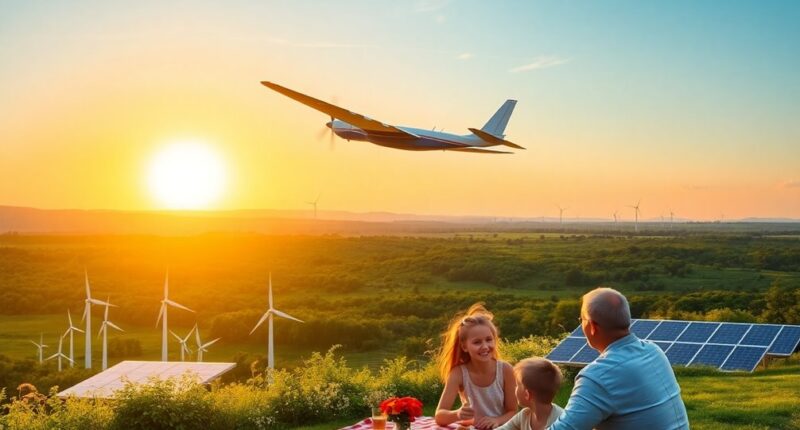Eco-aviation e-fuels are increasingly viable as household electricity costs rise. Created from CO2 and green hydrogen, these synthetic fuels offer a sustainable alternative to traditional fuels. They can significantly cut aviation emissions while being chemically identical to fossil fuels, requiring no infrastructure changes. Current tax policies favor their production, making them a more appealing option. This transition not only supports climate goals but also raises questions about energy equity. Discover what this means for the future of energy.
Key Takeaways
- Eco-aviation e-fuels, like e-kerosene, provide a sustainable alternative to fossil fuels for aviation and transport without infrastructure changes.
- The production of e-fuels utilizes renewable energy, making them increasingly cost-effective as household electricity prices rise.
- Taxation policies currently favor e-fuel production, potentially benefiting high-income households disproportionately.
- E-fuels support the EU's climate neutrality goals and the Fit For 55 initiative, aimed at reducing aviation emissions by 2030.
- The establishment of commercial e-fuel plants signals a growing shift toward sustainable energy solutions amid rising electricity costs.

As the world grapples with the urgent need to reduce carbon emissions, eco-aviation e-fuels emerge as a promising solution. These synthetic fuels, like e-kerosene, are crafted from CO2 and green hydrogen, providing a sustainable alternative to traditional fossil fuels. Thanks to innovative Power-to-Liquid (PtL) technology, they're produced using renewable electricity and Fischer-Tropsch synthesis, resulting in fuels that are chemically identical to their fossil counterparts.
You'll be pleased to know that e-fuels are suitable for aviation, maritime, and land transport without necessitating any modifications to existing infrastructure. This compatibility means you can feel good about using these fuels, as they offer a nearly carbon-neutral option when created with renewable energy sources. The first commercial plant in Germany is already operational, with plans for more sites worldwide, marking a significant step toward widespread industrial deployment. E-Kerosene can be used in existing combustion engines without modifications, making the transition to cleaner fuels even more feasible. Additionally, the primary uses of solar energy underline the importance of integrating renewable sources into various sectors to support sustainable fuel production.
The production process involves multiple methods, including Direct Air Capture (DAC), which sources CO2 from the air or industrial activities. Electrolysis extracts hydrogen from water using renewable energy, and Fischer-Tropsch synthesis converts CO2 and hydrogen into liquid fuels. This entire process requires substantial amounts of renewable electricity, reinforcing the need for sustainable energy sources.
In terms of climate impact, e-fuels align perfectly with ambitious sustainability targets like the EU's 2050 climate neutrality goals. The Fit For 55 initiative aims for a 5% Sustainable Aviation Fuel (SAF) use by 2030, showcasing e-fuels' crucial role in cutting aviation emissions. They're essential in helping achieve the Paris Agreement's climate objectives.
As household electricity costs soar, the cost comparison for e-fuel production becomes more favorable due to current taxation policies, which favor e-fuel over residential electricity. This situation raises concerns about energy justice, as the benefits might disproportionately favor higher-income households.
Ultimately, embracing eco-aviation e-fuels offers a pathway toward a more sustainable future while addressing pressing energy equity issues.
Frequently Asked Questions
What Are the Environmental Benefits of Using E-Fuels in Aviation?
You'll find that using e-fuels in aviation offers significant environmental benefits. They can reduce emissions by up to 80%, helping combat climate change.
E-fuels recycle CO2, contributing to carbon neutrality in the aviation sector. By utilizing renewable resources, they minimize competition with food crops.
Plus, their production can enhance grid resilience and improve air quality around airports. Embracing e-fuels supports cleaner air and a sustainable future for aviation.
How Are E-Fuels Produced and Sourced?
Imagine a baker crafting a cake from scratch, using the finest ingredients. E-fuels are produced similarly, combining water and carbon dioxide.
You'll find green hydrogen, created through renewable energy, as the key ingredient. Then, carbon dioxide is captured from the air or industrial emissions.
With synthesis methods like Fischer-Tropsch, you get various fuels like diesel or jet fuel, all aiming to replace traditional fossil fuels and support a cleaner future.
Are E-Fuels Cost-Effective Compared to Traditional Aviation Fuels?
E-fuels aren't currently cost-effective compared to traditional aviation fuels.
With prices significantly higher, you're looking at $114-367 per barrel for e-fuels versus $48-95 for fossil fuels.
Although technological advancements and regulatory support could lower costs in the future, substantial infrastructure investments are needed for scalability.
While the potential exists, you'll need to weigh the current pricing disparity against the environmental benefits when considering e-fuels for aviation.
What Is the Current Market Demand for Eco-Aviation E-Fuels?
You're likely surprised to learn that global demand for sustainable aviation fuels, including eco-aviation e-fuels, is forecasted to hit around 10 million tonnes annually by 2030.
While current production is only 0.3% of the jet fuel market, upcoming European mandates and significant investments in production facilities are set to boost this demand.
Despite market uncertainties, the push for carbon-neutral options makes e-fuels an exciting area to watch in the aviation sector.
How Do E-Fuels Impact Aircraft Performance and Safety?
E-fuels positively impact aircraft performance and safety by significantly reducing harmful emissions and soot particles.
You'll notice cleaner combustion leads to improved engine efficiency and health over time.
With decreased contrail and ice crystal formation, you enhance safety during flights by mitigating visibility issues and ice-related risks.
Conclusion
As household electricity costs continue to rise, eco-aviation e-fuels offer a promising alternative for reducing our carbon footprint. Did you know that using e-fuels could cut aviation emissions by up to 80% compared to conventional jet fuels? This statistic highlights the potential impact of e-fuels not just on the aviation industry, but on our environment as a whole. Embracing these innovations could be a game-changer, making air travel more sustainable for future generations.









